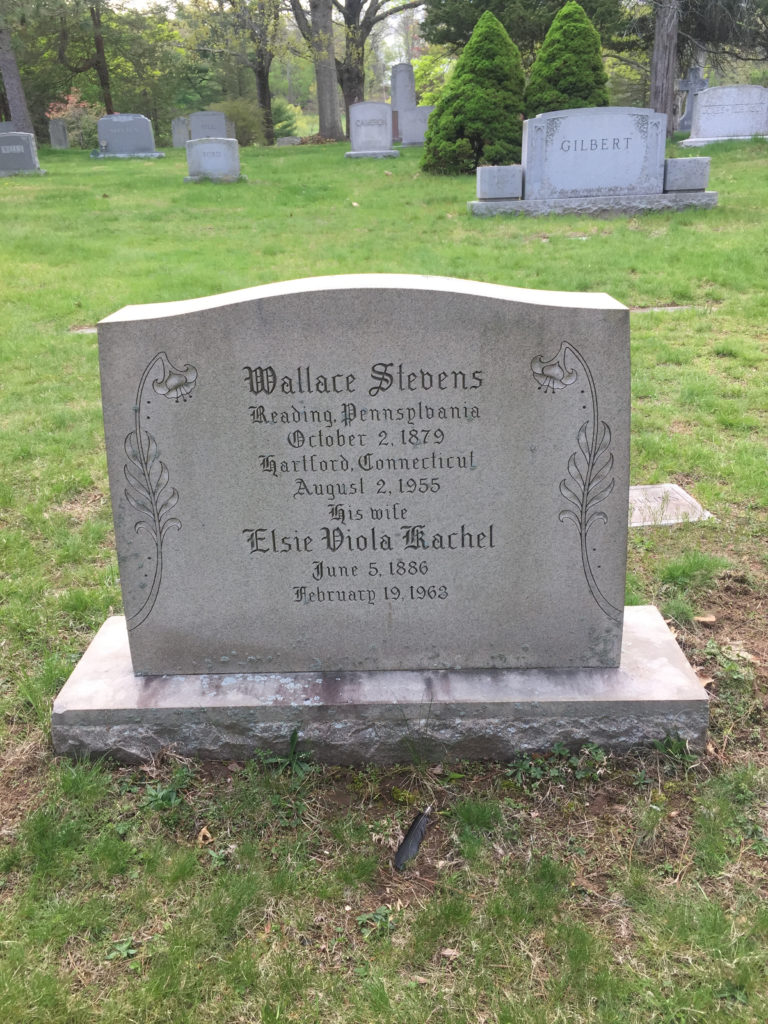Erik Visits an American Grave, Part 877
This is the grave of Wallace Stevens.

Born in 1879 in Reading, Pennsylvania, Stevens grew up in a German Lutheran family. His family was loaded, his father was a big-time lawyer, and so of course Wallace went to Harvard, though he had to drop out in 1900 due to some family financial setbacks. He went on to NYU Law, finishing that in 1903. He was a very successful lawyer as well. He was an insurance lawyer primarily and this side of his career was as successful and boring as anything the Hartford insurance houses can offer today. He was in New York for several years and then took a job with a Hartford firm in 1916, where he lived until he died. By 1934, he became the VP for The Hartford Financial Services Group. There truly is nothing more boring than insurance. Stevens was unquestionably good at it. And he never left it. Even though he had other financial opportunities due to his nigthtime career, there was no way he was going to give up the security that being an insurance executive offered.
That other career was, of course, poetry. It’s hard for me to think of any two things more oppositional than insurance and poetry. I mean, it’s one thing for a person to work where they need to work while they practice their art, but that was not Wallace Stevens. He was all-in on insurance, as much as he was poetry. It’s not that he was entirely conventional in his personal life. When his parents objected to him marrying a poor girl, he simply cut them out of his life entirely, never seeing his father again. So OK. But he always had the politics of the insurance executive as well, being a conservative Republican and, later in life, a huge supporter of the awful Robert Taft over those leftist Republicans like Thomas Dewey or Dwight Eisenhower.
So it’s a weird career. But Stevens is also one of the 10 most influential poets in American history. His first major work came out in 1914, when he was 35. But he was mostly an amateur until after he turned 40. His first book of poetry came out in 1923. A true modernist, his work was influenced by not only modernist writers, but also painters such as Paul Klee and Paul Cezanne. By the 50s, he was, along with Robert Frost (my sense is that they did not like each other or each other’s work), the leading poet in the United States. He published more in the 30s and 40s and then was quite productive in the 1950s. He won the National Book Award in 1951 for The Auroras of Autumn and then again in 1955 for Collected Poems. As always happens when I profile poets, I’m entering into an art about which I know nothing. But let’s just read a couple of poems. Here’s “Anecdote of the Jar”
I placed a jar in Tennessee,
And round it was, upon a hill.
It made the slovenly wilderness
Surround that hill.The wilderness rose up to it,
And sprawled around, no longer wild.
The jar was round upon the ground
And tall and of a port in air.It took dominion everywhere.
The jar was gray and bare.
It did not give of bird or bush,
Like nothing else in Tennessee.
Here’s “The Emperor of Ice Cream”
Call the roller of big cigars,
The muscular one, and bid him whip
In kitchen cups concupiscent curds.
Let the wenches dawdle in such dress
As they are used to wear, and let the boys
Bring flowers in last month’s newspapers.
Let be be finale of seem.
The only emperor is the emperor of ice-cream.Take from the dresser of deal,
Lacking the three glass knobs, that sheet
On which she embroidered fantails once
And spread it so as to cover her face.
If her horny feet protrude, they come
To show how cold she is, and dumb.
Let the lamp affix its beam.
The only emperor is the emperor of ice-cream.
One more: “The Snow Man”
One must have a mind of winter
To regard the frost and the boughs
Of the pine-trees crusted with snow;And have been cold a long time
To behold the junipers shagged with ice,
The spruces rough in the distant glitterOf the January sun; and not to think
Of any misery in the sound of the wind,
In the sound of a few leaves,Which is the sound of the land
Full of the same wind
That is blowing in the same bare placeFor the listener, who listens in the snow,
And, nothing himself, beholds
Nothing that is not there and the nothing that is.
I will leave it to you all sensitive souls to analyze all of this.
Stevens came down with stomach cancer in 1955 and died soon after. He was 75 years old. He remains an influential poet to other poets today, though again, I can’t speak to the specifics of this field.
Wallace Stevens is buried in Cedar Hill Cemetery, Hartford, Connecticut.
Stevens was the 96th volume published in the Library of America series, quite early for him. If you would like this series to visit some of the authors published by the LOA series shortly after his volume came out, you can donate to cover the required expenses here. I’ve visited the great James Baldwin, who had two volumes immediately after him. Eudora Welty, who was after Baldwin, is in Jackson, Mississippi and Charles Brockden Brown, who follows Welty, is in Philadelphia. Previous posts in this series are archived here.


